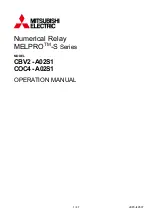
13
The slope of the time/current curves is deter-
mined by the values of the constants
α
and
β
:
Characteristic of the
α β
time/current curves
Normal inverse
0.02 0.14
Very inverse
1.0 13.5
Extremely inverse
2.0 80.0
Long-time inverse
1.0 120.0
According to the standard BS 142 of 1966 a
normal current range is defined as 2...20 times
the setting. Additionally the relay must start at
the latest when the measured current exceeds
1.3 times the set start current, when the time/
current characteristic is normal inverse, very
inverse or extremely inverse. At long-time in-
verse characteristic, the normal range according
to the standard is 2...7 times the set start current
and the relay is to start when the current exceeds
1.1 times the set start current.
The following requirements with regard to op-
eration time tolerances are specified in the stand-
ard, where E denotes accuracy in per cent, - = not
specified:
I/I>
Normal inverse
Very inverse
Extremely inverse
Long-time inverse
2
2.22 E
2.34 E
2.44 E
2.34 E
5
1.13 E
1.26 E
1.48 E
1.26 E
7
-
-
-
1.00 E
10
1.01 E
1.01 E
1.02 E
-
20
1.00 E
1.00 E
1.00 E
-
Over the normal current ranges, the inverse-
time stage of the overcurrent module SPCJ 3C3
complies with the tolerances of class 5 for all
four characteristics.
The time/current characteristics specified in the
standards are illustrated in Fig. 3, 4, 5, and 6.
Time/current
characteristics
The operation of the low-set current stage I> of
the overcurrent module is based on either defi-
nite time or inverse time characteristic. The
operation characteristic is selected with switch 3
of switchgroup SG1, see page 7.
When an I.D.M.T. characteristic is chosen, the
operation time of the low-set overcurrent stage
I> will be a function of the current; the higher
the current, the shorter the operation time. The
relationship between current and time comply
with the standards BS 142 of 1966 and IEC
255-4 and may generally be expressed as:
t = [s]
where t = operation time in seconds
k = time multiplier
I = measuring current
I> = set start current
The module includes four characteristics with
different slopes. The characteristic to be used is
chosen with switches 1 and 2 of switchgroup
SG1, see page 7.
k x
β
I
α
I>
( )
–1
















































